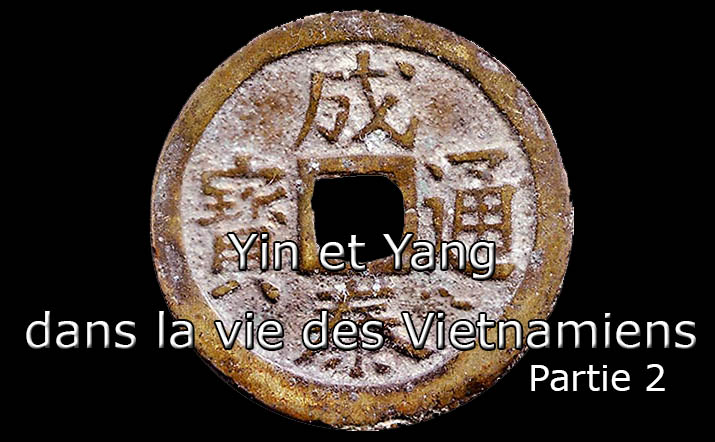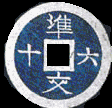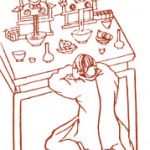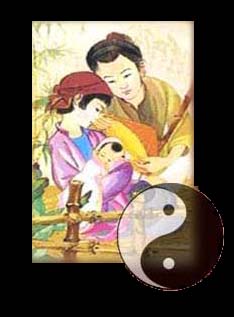When speaking of the symbolic couple circle/square, one wants to evoke perfection and happy union. Starting from a square with 4 sides, one can have an octagon by doubling the number of sides. Then by continuously doubling the number of these sides, one finally obtains a circle with no sides. It is the perfect form (perfectissima forma) testifying to absolute perfection. That is why it is customary to say in Vietnamese « Mẹ tròn, con vuông » to wish the mother and her child good health at the time of birth. This expression was handed down by our ancestors to draw our attention to the creative nature of the universe. Roundness and square are the two shapes taken not only by glutinous rice cakes (Bánh Chưng, Bánh Tết) or wedding cakes (Bánh Su Sê or Phu Thê) but also by ancient Vietnamese coins (or sapèques).
The shape of these sapèques is linked to traditional Vietnamese cosmology: the roundness of these coins evokes that of the sky, and the central hole is square like the earth.
Old coin
For the surface area of these sapèques, there is always a percentage to respect: 70% for the round part and 30% for the square part. These two shapes are also found in the bamboo cane held by the eldest son walking behind the coffin during his father’s funeral procession. When the deceased person is his mother, he is obliged to walk backward while looking straight ahead at the coffin. This is the « Cha đưa mẹ đón » (Accompany the father, receive the mother) protocol to be respected in Vietnamese funeral rites. The bamboo of the cane represents the father’s uprightness and endurance.
It is replaced by another plant known as « cây vong, » symbolizing simplicity, gentleness, and flexibility when the deceased person is the mother. The cane must have a round head and a square base to symbolize Heaven and Earth, while the middle part of the stem is reserved for the children and descendants. This means that everyone needs the protection of Heaven and Earth, the education of parents, and mutual assistance among siblings in society. To show respect, the number of times the guest is required to bow in front of the coffin must be a Yin number, i.e., an even number (i.e., 2 or 4), because the deceased person will join the world of darkness with a Yin character (Âm phủ in Vietnamese). According to Vietnamese researcher Trần Ngọc Thêm, everything closely or remotely related to death must use even numbers
(Yin = peace = death)
In the past, it was customary to place a piece of pure gold (Yang) in the mouth of the deceased to infuse the mana contained in the precious metal. Gold, representing the Yang principle, is capable of preserving the body and preventing decay.
At the moment of the deceased person’s agony, their relatives must give them a nickname (or in Vietnamese tên thụy) that only they and their close ones know, with the agreement of the household spirit, because on the anniversary of their death, this nickname will be mentioned to invite them to participate in the offerings and to avoid awakening other wandering souls. That is why it is customary to say in Vietnamese tên cúng cơm to remind that everyone has a nickname. Similarly, a bouquet of flowers offered at funerals must consist of an even number (or yin) of flowers.
There is an exception to this rule when it comes to Buddha or deceased parents. In front of their altar, it is customary to place 3 incense sticks in the vase or to prostrate completely on the knees, with the head touching the ground, an odd number (Yang) (con số dương, số lẻ) of times because they are still considered living beings. Likewise, to show respect towards living elderly people, one only performs one or three prostrations. However, in wedding rites, the bride must prostrate before her parents to thank them for her birth and education before joining her husband’s family.
It is the even number (or Yin số chẵn) of times she must perform (i.e., 2 or 4) because she is considered « dead » as she no longer belongs to her original family. There is a custom for the ceremony on the first wedding night. An older woman, who has many children and is considered good and honest, is asked to take charge of spreading and overlapping a pair of braids on the bridal bed: one open and the other placed upside down, symbolizing the union of Yin and Yang.
Mẹ tròn, con vuông
In the past, young couples used to exchange a pinch of soil for a pinch of salt. They wanted to honor and perpetuate their union and fidelity by taking Heaven and Earth as witnesses of their commitment. The same meaning is also found in the following expression: Gừng cay muối mặn, reminding newlyweds never to part because life is bitter and deep with ups and downs, just like the pungent ginger and salt that retain their flavor over the years.
For speaking of virtue, one is accustomed to say in Vietnamese:
Ba vuông sánh với bảy tròn
Đời cha vinh hiễn đời con sang giàu
As three squares can be in comparison seven circles, virtuous parents will have rich children.
By speaking of these three squares, one needs to reminder the square form of rice cake proposed during the new year. This cake constituted by straight lines symbolizes loyalty and righteousness in the relationship of three submissions « Tam Tòng »: Tại gia tòng phu, xuất giá tòng phu, phu tữ tòng tữ (submission to the father before her marriage,submission to the husband during her marriage, submission to the elder son when widowed).
About 7 circles, one must think of the roundness of « bánh giầy ». This one is constituted by a sequence of dots equidistant from the center where there is the heart. This cake is the symbol of a well-balancel soul that any passion does not bewinder. One finds in this heart the perfection of seven human sentiments: (Thất tình : hỹ, nộ, ái, lạc, sĩ, ố, dục )( Joy, anger, sadness, cheerfullness, love, hatred, desire). Does someone realize a ideal moral life if under any circumstances, he succeeds to maintain the loyalty and righteousness with others and always keeps his equidistant gap in the manifestation of his feelings?
The expression vuông tròn has frequently been employed in a great number of Vietnamese popular sayings:
Lạy trời cho đặng vuông tròn
Trăm năm cho trọn lòng son với chàng!
I pray to God that everything should go well and I should eternally keep my faithful hearth with you.
or
Đấy mà xử ngãi (nghĩa) vuông tròn
Ngàn năm ly biệt vẫn còn đợi trông
Here is the signification of conjugal love
Despite the eternal separation, one continues to wait for the return with patience
or in the following verses 411-412 and 1331-1332 of Kim Vân Kiều‘s best-seller
Nghĩ mình phận mỏng cánh chuồn
Khuôn xanh biết có vuông tròn mà haỵ
My fate is fragile like the dragonfly’s wing
Does the Heaven knows that this union is durable or not?
or
Trăm năm tính cuộc vuông tròn,
Phải dò cho đến ngọn nguồn lạch sông
During your life (one hundred years), when you are concerned about your marriage, you must go upstream to the source. (One must inquire about the bride’s family down to the smallest detail.)
This Yin and Yang bipolarity is expressed in various forms in Vietnam. In China, if there is a single marriage genius, in Vietnam there is a couple of male and female geniuses (Ông Tơ Bà Nguyệt). Likewise, in Vietnamese pagodas, there is a couple of male and female Buddhas (Phật ông Phật bà) on the altar instead of a single Buddha. Vietnamese people firmly believe that each of them is associated with a certain number of digits. Before birth, the embryo needs to wait 9 months and 10 days. To say that someone has a happy fate, it is said that they have a « happy destiny » (số đỏ). Conversely, the « unfortunate destiny » (số đen) is reserved for people with a bad fate.




